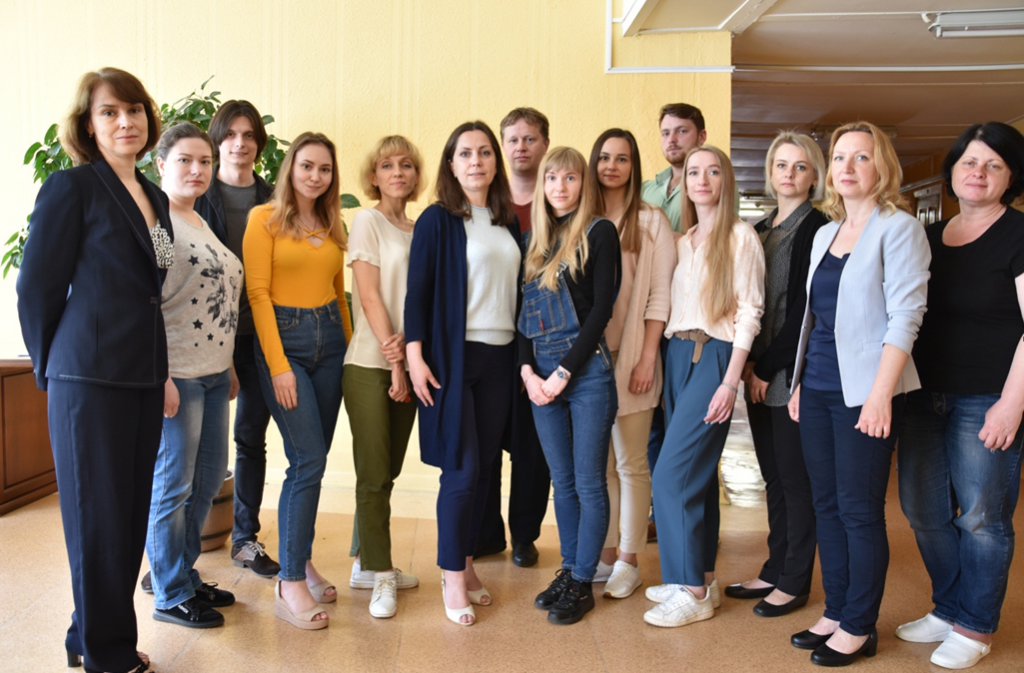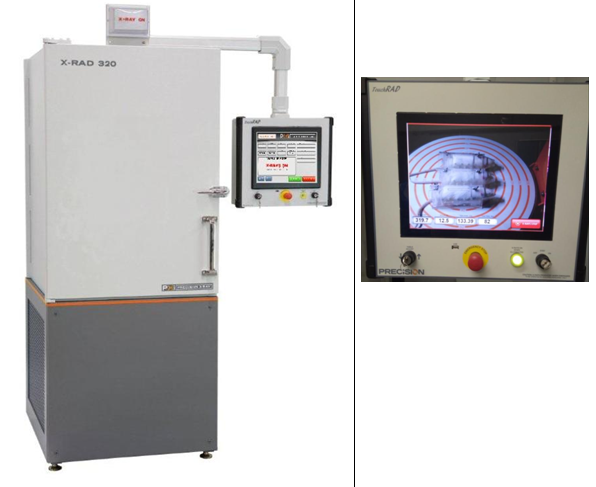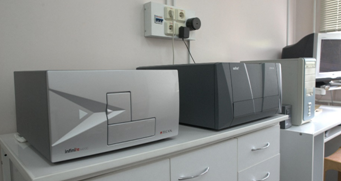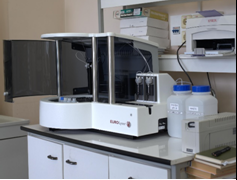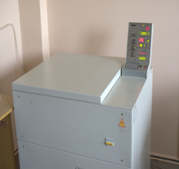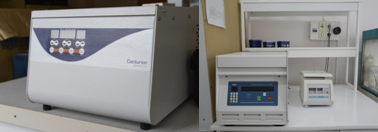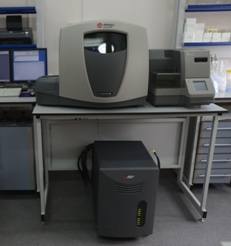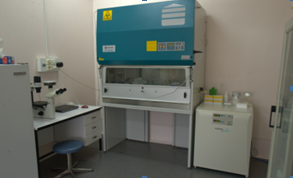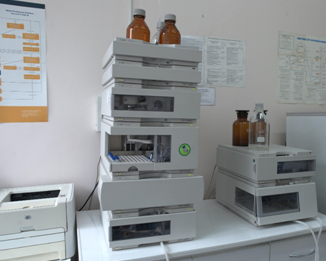Contact:
E-mail: lab.ubs@irb.basnet.by
The Laboratory studies physiological, biophysical and biochemical processes of a living organism under effects of various technogenic factors, including ionizing and non-ionizing radiation, in order to discover the ways of how to raise its radioresistance and adaptive capacities.
The main direction of research is focused on developing in vivo biological models using laboratory animals to study radiation and non-radiation effects on cellular and sub-cellular elements, and understand the mechanisms of malformations in pathological conditions of different genesis.
To achieve the set goals, the lab researchers:
- carry out experiments using in vivo and in vitro models to study radiation-induced pathologies;
- study spontaneous and induced carcinogenesis in biological models exposed to ionizing radiation;
- study molecular-cellular radiosensitivity mechanisms of biological systems;
- search for the novel medicinal substances possessing radiomodifying properties;
- study the process of the body’s adaptive capacity formation under chronic exposure to low-intensity electromagnetic radiation from wireless devices (e.g. mobile phones, Wi-Fi routers etc.);
- study nanomechanical properties of cells in various pathophysiological processes;
- investigate the structural and mechanical properties of nanoparticles in biological liquids (e.g. extracellular vesicles, lipoproteins etc.).
Head
Natalya CHUESHOVA, PhD in Biological Sciences
Research Staff
Maria STARODUBTSEVA, chief researcher, Dr. BioScs, Professor
Natallia VEYALKINA, lead researcher, PhD BioScs
Elena KADUKOVA, senior researcher
Nastassia SHKLIARAVA, researcher
Irina CHELNOKOVA, researcher
Elena SHCHUROVA, researcher
Vladislav SHCHEMELEV, researcher
Elena MEDVEDEVA, junior researcher
Anastasia PILOTOVICH, junior researcher
Snezhana NOVITSKAYA, junior researcher
Tamara MOKROUS, lab assistant
Elena SYUSKINA, lab technician
History
The Laboratory of BioSystems Sustainability was founded in 2020 by merging together three other labs, i.e. Laboratory of Experimental Biological Models, Endocrinology & Biochemistry Laboratory and Combined Effects Laboratory.
Endocrinology & Biochemistry Laboratory was founded in 2003 by combining four laboratories – Biochemistry, Physiology, Endocrinology, Morphology and Cytogenetics, which had been functioning before IRB permanently moved from Minsk to Gomel. The laboratory’s founder and long-time ruler in the first five years of its functioning was Academician of the National Academy of Sciences of Belarus, Honoured Scientist of the Republic of Belarus, Professor, Doctor of Medical Sciences Evgenij F. Konoplya. From 2009 to 2015, it was headed by Doctor of Biological Sciences, associate professor Alexander D. Naumov. In 2004 – 2015, the lab’s deputy head was lead researcher Gennadii G. Vereshchako, Candidate of Biological Sciences. The last head of the laboratory, from 2017 to 2020, was Grigoriy A. Gorokh.
laboratory for the development of nuclear-physical analysis methods and their application in biology and medicine, which was later transformed into laboratory of radioecology headed by Dr. A. Malenichenko. In 1992, following institutional rearrangements at the Institute of Nuclear Energy, the laboratory was reorganized into laboratory of radiation and toxicological ecology and became part of the Institute of Radioecological Problems of the National Academy of Sciences of Belarus. In 2003, the Institute of Radioecological Problems was reorganized and the laboratory became affiliated to the Institute of Radiobiology of the National Academy of Sciences of Belarus, which was soon after relocated from Minsk to Gomel.
The origin of Combined Effects Laboratory dates back to 1992 when it was established following institutional rearrangements taking place at the Institute of Nuclear Energy and creation of the Institute of Radioecological Problems of the National Academy of Sciences of Belarus. At that time, the lab was headed by Dr. A.F. Malenchenko and renamed into laboratory of radiation and toxicological ecology. In 2003, the Institute of Radioecological Problems was reorganized and the laboratory became affiliated to the Institute of Radiobiology of the National Academy of Sciences of Belarus, which was soon after relocated from Minsk to Gomel.
Laboratory of Experimental Biological Models was created in September 2014 and up until 2017 was headed by Dr. T.I. Milevich. The lab’s Radiation Exposure Sector was operating two gamma-radiation units, IGUR and GAMMARID, used for acute and chronic irradiation of biological objects. The outstanding work done by the unit operators over many years can be found reflected in quite a number of PhD and Doctoral theses authored by the home and external researchers.
Research Areas Today
The lab’s current research efforts fully match with the national priority directions with regards to scientific, technological and innovative activities set by the Government for the period 2021–2025, being as follows:
- the use of atomic force and fluorescent microscopy techniques to study structural and mechanical properties of the cellular surface layer, post-cellular structures and nano-scale organic and inorganic objects for the purposes of developing fundamental principles of innovative diagnostic approaches aimed at determining pathological conditions of a body at cellular and sub-cellular levels, and deepening our understanding of the pathogenesis of different health disorders, including radiation-induced pathologies;
- development of prognostic tests for the assessment of clinical radiation effects of radiotherapy;
- simulation of radiation-induced pathologies and validation of elaborated methods for their correction using laboratory animals;
- biodosimetry and assessment of a genetically predisposed radiosensitivity;
- the use of in vitro and in vivo models for the experimental research of cancer formation at different organizational levels of living organisms under exposure to various wavelengths of radiation (ionizing radiation, UV etc.), and investigation of the effect implementation mechanisms of normal and tumour cells;
- estimation and prediction of long-term biomedical effects of the low-intensity electromagnetic field generated by modern-time communication devices;
- gerontological studies of the effects of various stress factors, such as radiation-induced factors, stress, xenobiotics, towards improving the quality of life under changing habitat conditions.
Ongoing Research Projects
- Project “Development of age-associated morphofunctional alterations in individual organs of chest cavity exposed to radiation”, 2021–2025 State R&D Programme “Natural Resources and Environment” sub-programme “Radiation and Biological Systems”;
- Project “Develop the criteria for assessing radiation-induced changes of internal media tissues based on the analysis of the structure and mechanical properties of a cellular component using in vitro and in vivo models”, 2021–2025 State R&D Programme “Natural Resources and Environment” sub-programme “Radiation and Biological Systems”;
- Project “Estimate radiation doses to biota from combined effects of ionizing radiation and different stress factors in chronic radiation exposure situations”, 2021–2025 State R&D Programme “Natural Resources and Environment” sub-programme “Radiation and Biological Systems”;
- Project “Analysis of adaptation processes in animal species populations to chronic exposure to increased levels of ionizing radiation”, State R&D Programme “Convergence 2025”, sub-programme “Interdisciplinary Studies and Emerging Technologies”;
- Project “The effects of chronic exposure to low levels of electromagnetic radiation from Wi-Fi devices (2 450 MHz) on experimental animals during their postnatal development stages. Search for bioactive substances for the correction of the identified pathological alterations”, 2021–2025 State R&D Programme “Natural Resources and Environment” sub-programme “Radiation and Biological Systems”;
- Project “The mechanisms of the implementation, regulation and correction of the stable and cancer human cell viability under UV exposure with the use of lichen extracts”, 2021–2025 State R&D Programme “Natural Resources and Environment” sub-programme “Radiation and Biological Systems”;
- Project “Study the physiological and reproduction state of the horses kept inside the Polesie State Radiation-Ecological Reserve, 2021–2025 State Program on Overcoming the Consequences of the Chernobyl Disaster;
- BRFFR Project “CD109-regulated mechanical properties of endothelial cells”, Belarusian Republican Foundation for Fundamental Research (State Reg. no. 20200360);
- BRFFR Project “Mechanical characteristics of exosomes and exomers defining their interrelation with eukaryotic cells, in norm and in pathology”, Belarusian Republican Foundation for Fundamental Research (State Reg. no. 20201344).
Vivarium
Rendered Services
To see the full list of services provided by the lab, the contact and other details, please go here.
The Department’s Laboratory Equipment
In 2019, within the framework of Gratuitous Aid Agreement between Mission Support and Test Services, LLC (USA) and IRB, the laboratory equipment was essentially reinforced with an X-ray biological irradiation unit X-RAD 320, a self-contained X-ray system designed to deliver a precise radiation dosage to biological samples and small laboratory animals.
The X-RAD 320 unit offers the ability to experiment either with irradiation of the whole animal body or its specific parts and areas. Irradiation of cell cultures and suspensions in experiments in vitro is another advantageous ability of this instrument.
It is equipped with a built-in OptiMAX imaging module used in the variety of radiation therapy research and producing high-resolution optical molecular and X-ray images.
This unit is a perfect use for the variety of research purposes, from modelling ionizing radiation-induced pathologies and studying the mechanisms and effects of ionizing radiation at different organizational levels of biological systems to working out the ways of correction of somatic and cancerous diseases and evaluating remedial effects from different medicinal substances and materials.
The atom-force microscope AFM BioScope Resolve and an inverted fluorescence microscope Axio Observer 3 provides with a high-resolution examination of structural, mechanical and other cell properties, live cells in liquid media, nanoparticles etc.
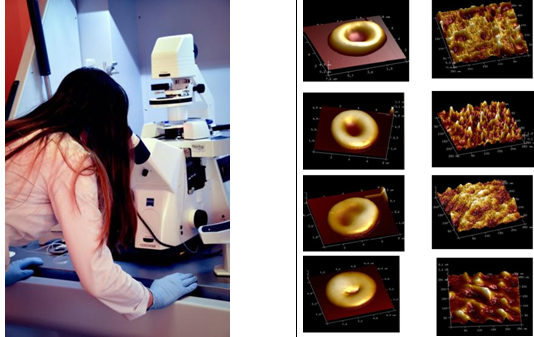
Microplate photometers / fluorometers / chemiluminometers
Tecan Safire 2 and Tecan Infinite M200
The multimode plate readers offer a range of detection techniques for the performance of photometry assays, fluorescence intensity measurements and chemiluminescence studies.
Automatic biochemistry analyzer EUROLYSER CCA 180
The analyzer with a throughput of up to 180 photometric tests per hour and an open-access sample and reagent carousels.
The Model L8-50ME Preparative Ultracentrifuge (Beckman Coulter, USA) is used to generate centrifugal forces for the separation of particles. With its rotor speed of up to 70,000 rpm, acceleration and deceleration profiles and a g Force rotation capacity of up to 226,000 × g, this centrifuge offers solutions to a range of tasks in molecular biology and cytology research.
The Refrigerating Centrifuge CR-01 (“NPO Center”, Belarus) is used to fractionate the blood and its components, i.e. plasma, serum, lymphocytes and erythrocytes, with a max Rcf of up to 2,500 G.
Refrigerated tabletop centrifuges
Centurion Scientific K220R and MPW-350R
Compact multi-purpose benchtop laboratory centrifuges
The Cytomics FC 500 Flow Cytometry System (Beckman Coulter, USA) performs an automated 5-color analysis using a single argon-ion laser with a wave length of 488 nm, and, with being able to analyze more antibodies per tube (e.g. immunophenotyping of blood lymphocytes), examine the ongoing changes in dispersed tissues (e.g. testicular tissue) and its other features, maximizing the method’s informative value and a workflow efficiency.
Cell culture equipment:
laminar-flow hood, CO2 incubator and inverted microscope
These pieces of equipment are used for microbiological, biomolecular, and cell (tissue, organ) culture research.
Particular attention is being paid to the use of high-efficiency liquid chromatography for the separation and purification of complex biological mixtures.
The Department’s research in this field is backed up by the Agilent 1100 Series Liquid Chromatograph, which helps to determine the concentrations of biogenic amines in different parts of the brain, as well as the steroid hormones in adrenal glands and blood serum.
Ongoing projects
Ongoing research projects:
- Project “The insight into the development of age-associated morphofunctional changes in individual organs under thoracic irradiation”, State R&D Programme on Natural Resources and Ecology, sub-programme “Radiation and Biological Systems”;
- Project “Develop the criteria for assessing radiation-induced changes of internal media tissues based on the analysis of the structure and mechanical properties of a cellular component using in vitro and in vivo models”, State R&D Programme on Natural Resources and Ecology, sub-programme “Radiation and Biological Systems”;
- Project “Estimate the doses and effects on biota from ionizing radiation combined with a stress of various origin in the area of chronic radiation exposure”, State R&D Programme on Natural Resources and Ecology, sub-programme “Radiation and Biological Systems”;
- Project “Analysis of adaptation processes in animal species populations to chronic exposure to increased levels of ionizing radiation”, State R&D Programme “Convergence 2025”, sub-programme “Interdisciplinary Studies and Emerging Technologies”;
- Project “The effects of chronic exposure to low levels of electromagnetic radiation from Wi-Fi devices (2 450 MHz) on experimental animals during their postnatal development stages. Search for bioactive substances for the correction of the identified pathological alterations”, State R&D Programme on Natural Resources and Ecology, sub-programme “Radiation and Biological Systems”;
- Project “The mechanisms of the implementation, regulation and correction of the stable and cancer human cell viability under UV exposure with the use of lichen extracts”, State R&D Programme on Natural Resources and Ecology, sub-programme “Radiation and Biological Systems”.
- Project “Study the physiological and reproduction state of the horses kept inside the Polesie State Radiation-Ecological Reserve, 2021–2025 State Program on Overcoming the Consequences of the Chernobyl Disaster;
- BRFFR Project “CD109-regulated mechanical properties of endothelial cells”, Belarusian Republican Foundation for Fundamental Research;
BRFFR Project “Mechanical characteristics of exosomes and exomers defining their interrelation with eukaryotic cells, in norm and in pathology”, Belarusian Republican Foundation for Fundamental Research.
Patents & Inventions
Patents
- Radioprotective substance. Authors: Vereshchako G.G., Khodosovskaya A.M., Soldatov V.S., Kuvaeva Z.I., Knizhnikov V.А., Pilchenko N.V. Patent no. 16556, Republic of Belarus. Application no. а20101403 of 30 April
- Dietary supplement and a method of the production thereof. Authors: Morozova А.А., Konoplya E.F., Ananieva N.V. Patent no. 15492, Republic of Belarus.
- Composition and a method of the production of a dietary supplement. Authors: Morozova А.А., Naumov A.D., Ananieva N.V. Patent no. 17766, Republic of Belarus.
- Dietary supplement and a method of the production thereof. Authors: Morozova А.А., Naumov A.D., Timokhina N.I., Ananieva N.V. Patent no. 17826, Republic of Belarus.
- Balneological means and a method of their production. Authors: Morozova А.А., Garanovich I.M., Naumov A.D., Timokhina N.I., Ananieva N.V. Patent no. 15715, Republic of Belarus.
- Balneological means and a method of the production thereof. Authors: Morozova А.А., Naumov A.D., Titok V.V., Kukhareva L.V., Stavrovskaya L.A., Ananieva N.V. Patent no. 17961, Republic of Belarus.
- Radioprotective drug. Authors: Chueshova N.V., Kozlov A.Ye., Cheshik I.A. Patent no. 23292, Republic of Belarus.
Inventions
- Based on the lab’s research of radioprotective properties of biologically active substances of natural origin, we have developed radioprotective agents based on stump fungi (mushroom) extracts, sodium succinate, biotin, antioxidant complex of vitamins with β-carotene, selenmethionine with methionine, exogenous DNA and others.
- Yet another R&D product of the lab’s efforts is an organic iodine-based dietary supplement Dopinat, which is now used in bakery and dairy food production to make, among others, iodized protein-enriched yogurts and mayonnaises.
- Based on the technical instructions developed by the lab and certified by the Ministry of Health of the Republic of Belarus, around 20 dairy enterprises throughout the whole country have launched production of approximately 9 000 tons of various types of dairy products enriched with innovative iodine casein.
Books, Monographs, Encyclopedias
Konoplya E.F., Vereshchako G.G., Khodosovskaya A.M. Enciklopedicheskij slovar radiobiologii (Encyclopedic Dictionary of Radiobiology, in Russian). Gomel: Gomel State Medical University, 2005; 251 p.
Morozova A.A., Konoplya E.F. Sredstva i sposoby zashchity organizma ot povrezhdayushchih faktorov vneshnej sredy (The ways and means of protecting the body of the damaging factors of the external environment, in Russian). Minsk: Belaruskaya Navuka, 2010; 395 p.
Vereshchako G.G. Vliyanie elektromagnitnogo izlucheniya mobil’nyh telefonov na sostoyanie muzhskoj reproduktivnoj sistemy i potomstva (The effects of electromagnetic irradiation from mobile phones on the male reproductive system and progeny, in Russian). Minsk: Belaruskaya Navuka, 2015; 190 p.
Vereshchako G.G., Khodosovskaya A.M. Radiobiologiya: terminy i ponyatiya : enciklopedicheskij spravochnik (Radiobiology: Terms and Concepts : Encyclopedic Guide, in Russian). National Academy of Sciences of Belarus; Inst. of Radiobiology. Minsk: Belaruskaya Navuka, 2016; 335 p.
Publications
Vereshchako G.G., Khodosovskaya A.M., Konoplya E.F. Protivoluchevaia zashchita muzhskoi reproduktivnoi sistemy: sostoianie voprosa i problemy, voznikshie posle avarii na Chernobylskoi AES (The problem of radiation protection of male reproductive system following the Chernobyl NPP disaster, in Russian). Uspekhi sovr. biologii, 2011; vol. 131 (1); p. 16-29.
E.F. Konoplya et al. Vliianie radioekologicheskikh uslovii zony otchuzhdeniia ChAES na morfofunktsionalnoe sostoianie i reaktivnost organov i tkanei laboratornykh zhivotnykh (The influence of radioecological conditions in the Chernobyl NPP exclusion zone on morphofunctional state and responsiveness of organs and tissues of laboratory animals, in Russian). Radiation Biology. Radioecology, 2011; vol. 51 (1); p. 1-11.
G.G. Vereshchako et al. Vliianie anabolika fenobolina na krov, reproduktivnuiu sistemu i uroven gormonov v syvorotke krovi krys-samtsov, obluchennykh fraktsionirovanno (The effect of anabolic fenobolin on blood, reproductive system and hormone level in blood serum of male rats under fractional exposure, in Russian). Radiation Biology. Radioecology, 2011; vol. 51 (3); p. 337-344.
Ye.F. Konoplya, G.G. Vereshchako, G.A. Goroh et al. The effect of chronic radiation exposure of ChNNP exclusion zone on the morfofunctional state and reactivity of organs and tissues of laboratory animals. // The lessons of Chernobyl. 25 years later. Elena B. Burlakova, Valeria I. Naydich / Chapter XIV. Nuclear materials and disaster research. Nova Science Publishers, Inc., New York, 2012; p. 173-186.
A.A. Morozova et al. Novye balneologicheskie sredstva rastitelnogo proiskhozhdeniia (New plant-based balneological medicines, in Russian). Doklady of the National Academy of Sciences, 2013; vol. 57 (2); p. 91-97.
G.G. Vereshchako. Problemy reproduktsii u muzhchin, vyzvannye ispolzovaniem mobilnogo telefona (Reproduction problems of males due to the use of mobile phones, in Russian). Problemy reprudukcii = Reproduction Problems, 2014; no. 4; p. 73-78.
Vereshchako G.G., Chueshova N.V., Gorokh G.A., Naumov A.D. Sostoianie reproduktivnoi sistemy krys-samtsov 1-go pokoleniia, poluchennykh ot obluchennykh roditelei i podvergnutykh vozdeistviiu EMI (897 MGts) v period embriogeneza i postnatalnogo razvitiia (Reproductive system of first-generation male offspring of irradiated parents following their exposure to EMR (897 MHz) during embryogenesis and postnatal development, in Russian). Rad. Biol. Radioecology, 2014; vol. 54 (2); p. 186-192.
- I. Timokhina, S. N. Sushko, N. N. Veyalkina, S. V. Goncharov, V. V. Truhonovets. Biologicheski-aktivnye svoistva vodnykh ekstraktov kultivirovannykh gribov Hericium erinaceus (The bioactive properties of aqueous extracts of cultured mushrooms Hericium Erinaceus, in Russian). Problemy zdorovia i ekologii, 2017; vol. 52 (2); p. 71-74.
G.G. Vereshchako, N.V. Chueshova. Reaktsiia organov reproduktivnoi sistemy i epididimalnykh spermatozoidov krys na elektromagnitnoe izluchenie ot mobilnogo telefona (1800 MGts) razlichnoi prodolzhitelnosti (Reactions of reproductive organs and epididymal sperms of rats on electromagnetic exposure from a mobile phone (1800 MHz) of different time length, in Russian). Rad. Biol. Radioecology, 2017; vol. 57 (1); p. 71-76
Timokhina N.I., Nadyrov E.A., Veyalkina N.N., Sushko S.N., Goncharov S.V., Fabusheva K.M. Genetically-caused tumor formation in lungs of mice of line Af under influence of radiation and chemical factors, and at aging. Journal of Anatomy and Histopathology. 2018; 7(3): 56-60. doi: 10.18499/2225-7357-2018-7-3-56-60. (In Russian.)
Trukhanavets V.V., Kadukova A.M., Veyalkina N.N., Sushko S.N., Puchkova T.A., Bisko N.A., Shahovskaya O.V., Kozlov A.E., Miadzvedzeva A.A., Kolody T.A. Introduction of the medicinal mushroom Ganoderma lucidum (Curt.: Fr.) P. Karst. in culture and prospects of its practical use in the radioactive pollution conditions. Journal of the Belarusian State University. Ecology. 2019;4:62-70. Russian.
M.N. Starodubtseva, I.A. Chelnokova et. al. Nano- and microscale mechanical properties of erythrocytes in hereditary spherocytosis. J. Biomechanics. 2019. Vol. 83. Р. 1-8.
J.-M. Bertho et. al. Assessment of population radiation exposure at the edge of the exclusion zone 32 years after the Chernobyl accident: methods and preliminary results. Radioprotection. 2019. 54 (4). P. 247-257.
Chueshova N. V., Vismont F. I. Long-term effects of electromagnetic radiation of the mobile phone frequency on the morphofunctional state of the reproductive system of rats and males and their offspring. Doklady Natsional’noi akademii nauk Belarusi = Doklady of the National Academy of Sciences of Belarus, 2019, vol. 63, no. 2, pp. 198-206 (in Russian). https://doi.org/10.29235/1561-8323-2019-63-2-198-206
Chueshova N. V., Vismont F. I., Cheshyk I. А. Effect of electromagnetic radiation from a mobile phone (1745 MHz) on the condition of the reproductive system of male rats during their postnatal development. Vestsi Natsyyanal’nai akademii navuk Belarusi. Seriya meditsinskikh navuk = Proceedings of the National Academy of Sciences of Belarus. Medical Series, 2019, vol. 16, no. 2, pp. 216-225 (in Russian). https://doi.org/10.29235/1814-6023-2019-16-2-216-225
